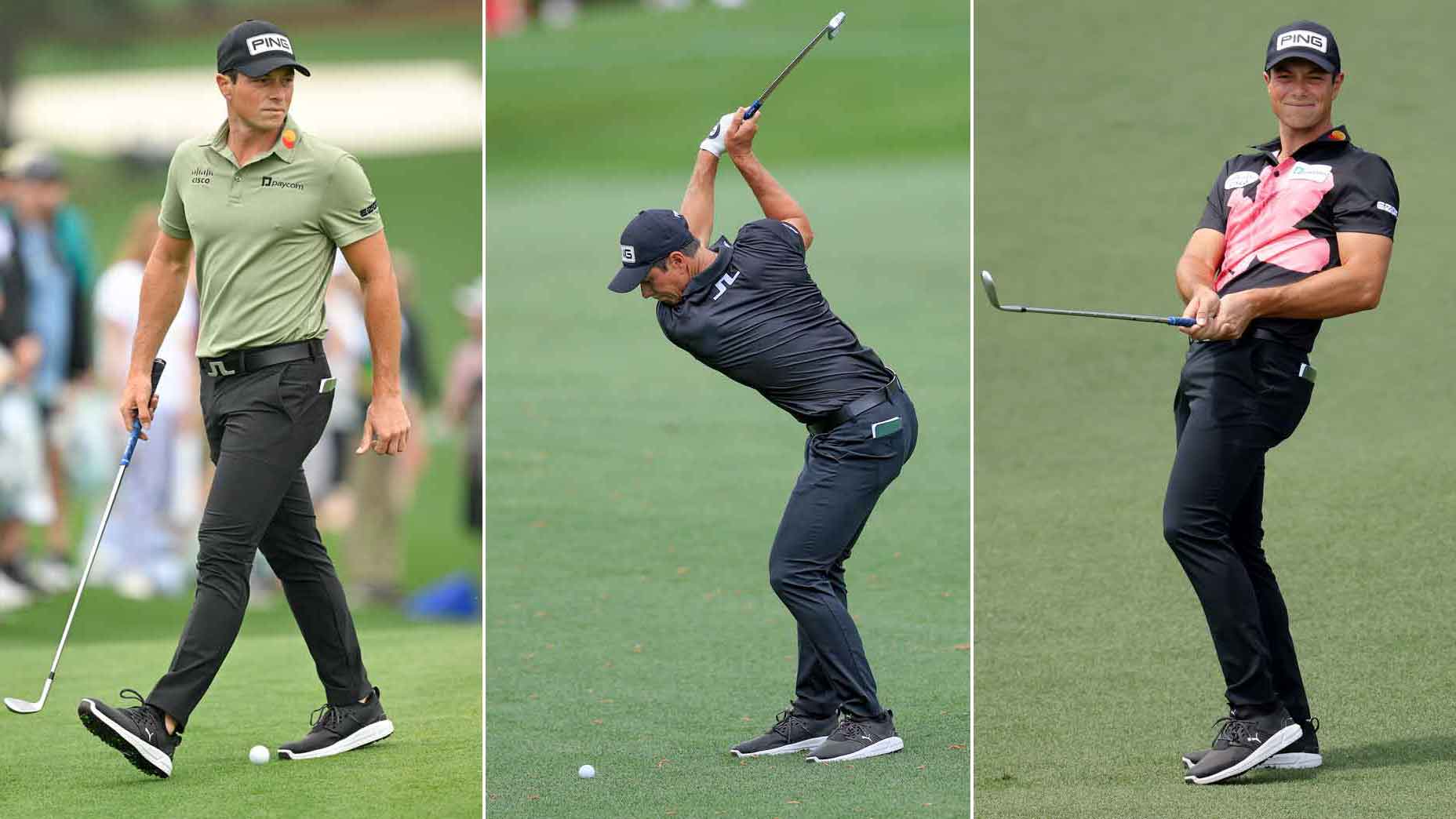Welcome to another edition of Yo, Gear Guy!, an interactive GOLF.com series in which our resident dimplehead (a.k.a., GOLF’s deputy editor of equipment, Mike Chwasky) fields your hard-hitting questions about clubs, fittings, gadgets, bounce, lofts, CG, MOI, and a bunch of other scary acronyms. Got a question for Gear Guy? Hit us up on Twitter or Facebook.
OldSportGolf on Reddit: How much distance should I expect to lose on balls in colder weather? Is there a variance, based on ball type (surlyn/urethane or high/low compression)? Is there a best type of ball for winter play?
Cold weather can affect ball performance in a couple of ways, and neither of them is good. First, cold air is denser than warm air and will typically cause shots to fly a shorter distance (according to Titleist you’ll lose about 1.5% of distance for every 20-degrees of air temperature drop). To combat this issue, it’s best to play with balls that are stored at room temperature (the car trunk is also bad in cold weather), as “cold” balls will have less resiliency, speed, and distance. It’s also smart to keep a ball in your pocket on cold days and rotate it with another ball to help maintain a somewhat consistent temperature.
On cold days a softer feeling ball (urethane cover, lower compression, or both) might provide a better sensation at impact, particularly around the greens. Lower compression models also help offset the increased compression caused by cold temps and might fly a bit longer than a firmer model. However, if you store your normal gamers at the proper temperature (not in your cold garage or car trunk), it shouldn’t matter too much as long as you rotate balls during the round.

byodinsfrostybeard on Reddit: What shoes would you recommend for someone who frequently walks 7,000+ yard courses?
A good question that I personally had to learn the answer to the hard way. One of the first times I was lucky enough to play at Bandon Dunes (when they only had Bandon and Pacific), I made the stupid decision to bring a new pair of shoes that were the same brand, model, and size that I normally wore. What I found when I put them on before heading out to the first tee of Pac Dunes was that they were inexplicably about a half-size too big, and that my feet and toes were naturally trying to hold on so they wouldn’t slide around while I walked. The result after seven or eight holes was a stabbing pain (like an actual knife sticking into the bottom of my foot) that made me seriously question whether or not I could finish, let alone enjoy the round. In fact, I had to have a caddie come out and haul my pull cart on the back nine while I literally limped to the finish. The next day I could barely walk and only made it around nine holes.
The moral of the story should be obvious: Regardless of what brand, model, or type of shoe you prefer, make sure you get a proper fit. If you don’t know much about your feet and what type of sole or last works best for you, there are several companies, including FootJoy, that can provide an analysis. Though some cart riders might laugh at my story and poo-poo the importance of properly fitted shoes, the reality is it’s not only a question of foot health and comfort while walking. The right shoes can actually help your balance and improve the efficiency and power of your swing.
Slayer F-150 on Reddit: Can you explain tungsten weighting and how different weights and weight position affect the clubhead of a driver?
Tungsten is a great material for club weights because it’s extremely dense, allowing designers to place a lot of weight in a small space. Other than that, Tungsten doesn’t have any magical powers. Tungsten weights (and stainless steel, too) are used for a variety of reasons, but typically the purpose is to help position the CG (center of gravity) in a specific location to promote a specific type of performance.
When it comes to drivers, there are basically three common locations for sole/head weights: (1) in the heel to help the clubhead close more quickly, which helps counteract slicing, (2) in a low and deep spot to increase MOI and encourage higher launch and forgiveness, and (3) toward the front of the head, closer to the clubface, to increase ballspeed and reduce spin.
If you want to dial in your adjustable driver, you might want to take a quick trip to your local custom fitter that has a launch monitor and knows how to combine the moveable weight adjustment with the loft and face angle adjustments. If you’re thinking about buying a driver with fixed sole weights, get it fitted before you buy.
Herbk99 on Twitter: I’m a 12 handicap: Should I be playing blades or cavity backs?
No offense but this is one of those questions that some players continue to ask, though it’s been years since there was much doubt about the answer. The term “blade” can mean several things, though generally it refers to clubhead size (small), offset (minimal), sole width (narrow), and technology/distance/forgiveness (little to none). It can also refer to muscleback vs. cavity back, but that’s actually less important than the overall design.
The reason the question is not necessary to ask is that the “blade” design is basically not useful for the vast majority of players, excluding the most accomplished golfers, including professionals, Division I stars, and top amateurs. While your handicap indicates you’re a pretty decent stick, if you’re not taking advantage of modern technology, meaning cavities, flexible clubfaces, wider soles, lower CGs, speed slots, etc., you’re definitely making a big mistake. Another way to look at it is, if you’re not practicing on a regular basis and working on manipulating your trajectory, shot shape, and distance, you probably shouldn’t bother looking at a better player’s iron.
GambitX on Reddit: How much distance am I shaving off a 3-wood if I cut it down 2 inches? I like the consistency of swinging a short club, but if it is the same distance as a standard 4 hybrid I might as well hit the hybrid off the tee.
In theory every inch of shaft length you cut off can cost you about 1 mph of clubhead speed, so the math on a two-inch reduction isn’t that complicated (by some estimates 1 mph of clubhead speed equates to two or three yards of distance). However, as we all know humans are not Iron Byrons and there are a lot of variables that contribute to the quality and distance of shots, not the least of which is solid contact (smash factor). If you make better contact and load the shaft more efficiently at a shorter length, you actually might increase the average distance of your three-wood rather than reduce it. And believe it or not, some people actually swing a shorter club faster as well.
Not sure how you came to the two-inch number, but I would strongly suggest reducing by half-inch increments at first to see how your swing, ballstriking, and distance are affected. You should also consider testing it on a launch monitor so you can see how your smash factor changes, if at all. Also keep in mind that significantly reducing shaft length will also reduce the club’s overall weight, which along with the club’s swingweight will most likely need to be adjusted.
Gordy on Facebook: I saw you mention last edition that you shouldn’t store clubs and balls in a trunk. I do that because I try to go play after work once or twice per week. So what happens when they’re left in a 100+ degree trunk?
Excessive heat degrades lots of materials, including just about everything used to manufacture golf gear. From the various ionomer (plastic) and rubber materials used in balls to the composite in graphite shafts (and even the rubber in your grips), it all can and will be negatively effected by sitting in what basically amounts to an oven. Balls will lose resiliency and speed, just like the graphite/composite shafts you have on your woods and/or irons. Warping, weakening, and even breakage can also result, forcing you to repair or replace various items. We all know the significant investment required to build a solid set of golf gear — taking care of it will help you enjoy the game more and potentially save you some money as well.







